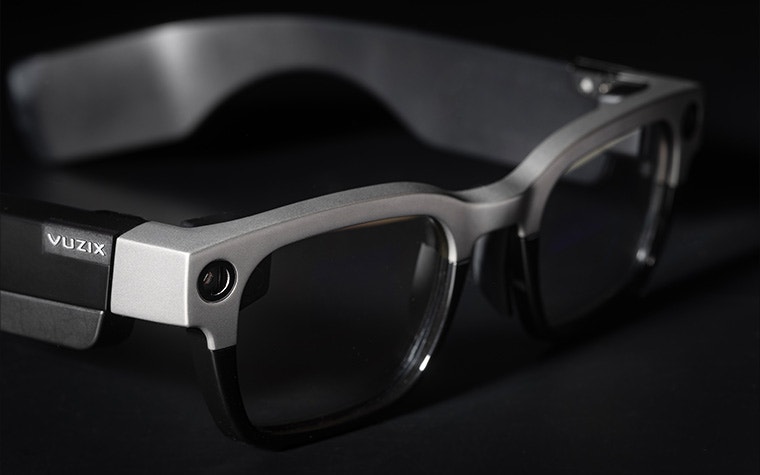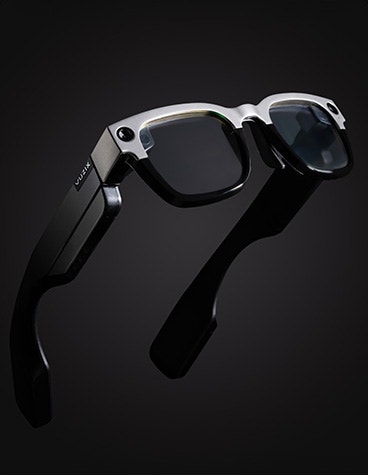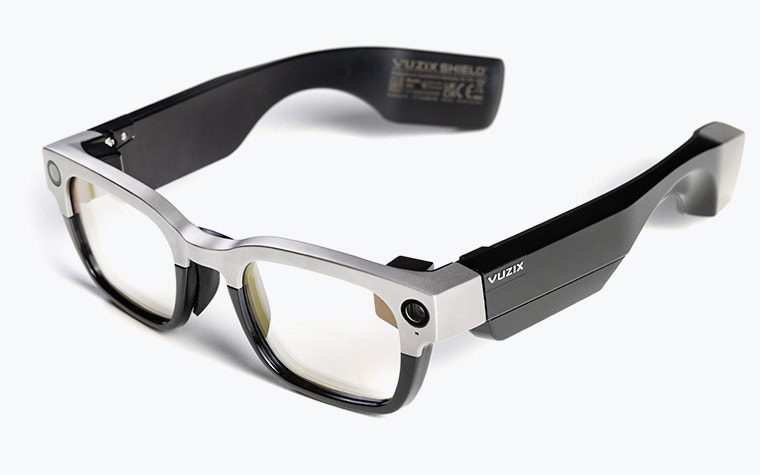CASE STUDY
Fashion. Function. Fit. Meet the Vuzix Shield and Its 3D-Printed Titanium Bridge

Vuzix has been a leader in the smart glasses industry since its inception. Specializing in waveguide optics and advanced manufacturing, they continue to move the industry forward with their latest enterprise offering: meet the Vuzix Shield and its highly functional 3D-printed titanium bridge.
The challenge
Strength, stability, and style
Vuzix Shield, the company's latest entry into the enterprise market, is one of the most advanced binocular smart glasses available today — yet all its tech and features are included within a traditional eyewear form factor. As with all forward-looking innovations, developments like this come with challenges, both new and familiar.
“These glasses have a display in each temple, sitting in a fixed component,” explains Shane Porzio, VP of Engineering at Vuzix. “If anything's out of alignment, especially on binocular systems, you literally can't use the images. So, from user to user, taking them on and off, beating them up, these things all have to stay aligned within a pixel for rotation and vertical and horizontal positioning. That means we can’t afford any twisting, rocking, or ratcheting across the front frame.”


Understandably, ensuring this stability is complex. A lot of consideration went into the design, fuelled by a deep understanding of how the human eye works and how consumers wear their glasses. But, when bringing the model into production, Vuzix soon identified an issue.
“We initially started with injection molding, trying both carbon-filled and glass-filled plastics. But no matter what the industrial design was, we couldn’t get the support rigid enough. If you were just wearing the glasses on their own, they were fine. But if you connected a cable to the battery in your pocket, for example, it could put just enough torque on the glasses to cause a slight misalignment from right to left.
“So, we took a step back and decided to go down another route to make the support structure these frames really needed.”
Though building a strong, stable frame was priority number one, it wasn’t the only consideration. After all, eyewear is eyewear, no matter how smart it gets. The three F’s — fashion, function, and fit — are just as important to Vuzix as they are to a traditional eyewear brand. It was crucial that any solution looked as good as it worked, making it appeal to a broad audience.
“Since day one, Vuzix’s mission has been to make lightweight, wearable devices that can go to work,” says Paul Travers, President and CEO of Vuzix. “But for any eyewear to become part of the mass market, they have to be fashion-friendly. It's taken years of technological innovation to get to the point where smart glasses with displays like this finally start to look like traditional glasses.
“That’s the fashion and form part of all of this. They go hand in glove — miss out on any of them, and you end up with a product that won’t sell. The look might not be quite so important in the industrial or commercial arena because there’s an ROI from using them as a tool, but all-day wearability is critical. So, there’s a lot of form, function, and fit that has to be right there, too.”
The solution
3D-printed titanium from a dedicated eyewear production line
Being familiar with the quality of our dedicated eyewear production line through a longstanding partnership, Porzio and his team worked with Materialise to find a solution. Having identified the main issue — the rigidity of the top of the frame — and knowing what was required of the design — strength, stability, and style — the two soon began testing and evaluating materials.
The solution was something as unique as the Shield itself: 3D-printed titanium. The material is famously strong and lightweight, making it an obvious choice for applications like this. As metals go, it's also particularly eye-catching — high-end brands like Porsche and McLaren trust it for their own eyewear lines, while the word is front and center in the marketing of other popular consumer goods, like smartphones.


“Our teams took the initial design of the frame and worked on titanium prototypes,” says Jan-Willem Billiet, Head of Smart Eyewear at Materialise. “It was critical to find the right weight, design, and form factor to give Vuzix the quality these frames demand.”
The Shield’s temples contain the CPU and batteries, meaning they’re already a little thicker than average, but by ensuring the newly designed 3D-printed front connects easily to the remaining components, other materials can be used in that area. As a bonus, a hybrid frame further reduces the weight, increasing comfort and wearability.
However, it wasn’t just material characteristics that helped shape Vuzix’s decision — the qualities of 3D printing couldn’t be ignored either. Whether it’s the absence of minimum order quantities, a flexible supply chain setup with a rapid turnaround and time-to-market of only three months, or the potential to easily add customization options in the future, it’s an ideal technology for the smart eyewear industry right now.
“We’ve worked with Materialise for over two years, so we know that their materials are top-notch. Even our prototype frames look and feel like a production-ready pair of glasses”
“In a situation like this, if you think about how we’re trying to get this just right, there’s a lot of iteration that has to happen,” says Porzio. “3D printing with Materialise affords that very well. You make a cut, find something that doesn’t work or you don’t like, so you make another cut, then another — if you were doing that with injection molded parts, it would be incredibly expensive and time-consuming because of the tooling changes and the like. With 3D printing at Materialise, our iterative design process allows for lightning-fast prototyping.”
Having settled on the final design, the process moved on to production. Here, Materialise and Vuzix combined their expertise to identify the tight tolerances required. Together with our post-processing capabilities, titanium parts are accurate to within 0.1 mm, while a high-quality finish gives the Vuzix Shield that extra touch of luxury, ensuring the frames didn’t just function as intended — they looked great, too.
The result
Beautiful, smart, and high-quality eyewear with enormous potential
“We’ve worked with Materialise for over two years, so we know that their materials are top-notch. Even our prototype frames look and feel like a production-ready pair of glasses,” says Porzio. “And the same is true in this capacity, supporting the backbone of our frames. Firstly, they did a great job helping us get the rigidity we needed from a printed device. Then there’s the finishing work they did on that printed device. Quite frankly, it’s a beautiful piece of technology.”


The Vuzix Shield: fashion, function, and fit guaranteed. ©Vuzix
“There’s a huge need for 3D-printed glasses with a fast turnaround in this space, and Materialise definitely has a role to play.”
Vuzix Shield's incredibly smart features have the potential to make a big difference in the world. Its uses extend far beyond the enterprise space, including medical applications, remote support, and as a tool for the hearing impaired. It's certainly a watershed moment for 3D-printed eyewear, particularly smart glasses. The question is, what comes next?
“Alongside the Shield, we see a series of products coming that have small, medium, and large sizes and different looks and feels. People like choice — you walk into a Sunglass Hut, and it’s not like there’s one pair of sunglasses sitting there. That’s what the smart eyewear industry is going to look like in the future," says Travers.
Offering customization at scale is definitely one area where 3D printing shines. New colors, new shapes, new materials — from plastics to metals like titanium — anything is possible, and the options are only getting better as time goes on. It's early days for the industry, but when forward-thinking designers like the team at Vuzix take advantage of all it has to offer, the sky truly is the limit.
“For me, even after being in it for 26 years, this industry is still quite new. The world is only just waking up to it, and the designs are reaching a point where we can take advantage of these small engines and waveguides,” Travers continues. “That means the number of iterations is significant, the number of spins you need to do to get the design just right and ship it to a customer, everything will need to be customized. There’s a huge need for 3D-printed glasses with a fast turnaround in this space, and Materialise definitely has a role to play.”
Header image: ©Vuzix
Share on:
This case study in a few words
Eyewear
- Metal 3D printing
- Design for AM
- 3D-printed titanium
- Titanium is strong, lightweight, and offers a premium look and feel
- 3D printing and post-processing services offer incredible accuracy of >0.1 mm
- Design for AM ensures the titanium part easily connects to the rest of the frame
